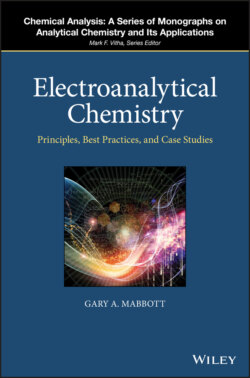Читать книгу Electroanalytical Chemistry - Gary A. Mabbott - Страница 2
Table of Contents
Оглавление1 Cover
2 Preface
3 1 Basic Electrical Principles 1.1 Overview 1.2 Basic Concepts 1.3 Electrochemical Cells 1.4 The Electrified Interface or Electrical Double Layer 1.5 Conductance 1.6 Mass Transport by Convection and Diffusion 1.7 Liquid Junction Potentials References
4 2 Potentiometry of Oxidation–Reduction Processes 2.1 Overview 2.2 Measuring “Open Circuit” Potentials 2.3 Solution Redox Potential References
5 3 Potentiometry of Ion Selective Electrodes 3.1 Overview 3.2 Liquid Membrane Devices 3.3 Glass Membrane Sensors 3.4 Crystalline Membrane Electrodes 3.5 Calibration Curves and Detection Limits 3.6 A Revolutionary Improvement in Detection Limits 3.7 More Recent Ion Selective Electrode Innovations 3.8 Ion Selective Field Effect Transistors (ISFETs) 3.9 Practical Considerations REFERENCES
6 4 Applications of Ion Selective Electrodes 4.1 Overview 4.2 Case I. An Industrial Application 4.3 Case II. A Clinical Application 4.4 Case III. Environmental Applications 4.5 Good Lab Practice for H Electrode Use References
7 5 Controlled Potential Methods 5.1 Overview 5.2 Similarities between Spectroscopy and Voltammetry 5.3 Current is a Measure of the Rate of the Overall Electrode Process 5.4 Methods for Avoiding Background Current 5.5 Working Electrodes 5.6 Pulse Amperometric Detection 5.7 Stripping Voltammetry 5.8 Special Applications of Amperometry 5.9 Ion Transfer Voltammetry References
8 6 Case Studies in Controlled Potential Methods 6.1 Overview 6.2 Case I. Evaluating the Formal Potential and Related Parameters 6.3 Case II. Evaluating Catalysts – Thermodynamic Considerations 6.4 Case III. Studying the Oxidation of Organic Molecules 6.5 Case IV. Evaluating Catalysts – Kinetic Studies References
9 7 Instrumentation 7.1 Overview 7.2 A Brief Review of Passive Circuits 7.3 Operational Amplifiers 7.4 Noise and Shielding 7.5 Making Electrodes and Reference Bridges References
10 Appendix A: Ionic Strength, Activity, and Activity CoefficientsIonic Strength, Activity, and Activity Coefficients References
11 Appendix B: The Nicolsky–Eisenman EquationThe Nicolsky–Eisenman Equation References
12 Appendix C: The Henderson Equation for Liquid Junction Potentials1 Reference Note
13 Appendix D: Standard Electrode Potentials for Some Selected Reduction ReactionsStandard Electrode Potentials for Some Selected Reduction Reactions References
14 Appendix E: The Nernst Equation from the Concept of Electrochemical Potential1 Reference Note
15 Solutions to Problems
16 Index
17 Chemical Analysis
18 End User License Agreement
